| |  Nowadays I do not get to play as many tournaments as I used to, so heading into the 2012 Mass Open I decided to play every game out to the end without worrying too much about results. The tournament was very strange for me, as I felt I played quite well, but I finished with a rather dismal 3.5-2.5 score. Looking back at the games, I felt I was very close to getting something more like 5.5-.5, but my opponents also played well and my little mistakes proved to be costly. After a quick first round win, I ended up in a 6 hour marathon against FM Nelson Castaneda. Nowadays I do not get to play as many tournaments as I used to, so heading into the 2012 Mass Open I decided to play every game out to the end without worrying too much about results. The tournament was very strange for me, as I felt I played quite well, but I finished with a rather dismal 3.5-2.5 score. Looking back at the games, I felt I was very close to getting something more like 5.5-.5, but my opponents also played well and my little mistakes proved to be costly. After a quick first round win, I ended up in a 6 hour marathon against FM Nelson Castaneda.
FM N.Castaneda (2385)
IM D.Vigorito (2557)
MA Open, 2012
[A04] Reti Opening
1.c4
Already a surprise. I thought Nelson was just a 1.e4 player, but lately I have seen him mixing it up a bit. Recently he played 1.d4 against me too.
1…g6 2.Nf3 Bg7 3.g3 c5 4.d4 cxd4 5.Nxd4 Nc6 6.Nxc6
This is rather unusual, but not necessarily bad.
6…bxc6 7.Bg2
7…Rb8
This is not a bad move, but I hindsight I would have preferred 7...Nf6.
8.0–0!? Nf6
And so I changed my mind…
Black cannot play 8...Bxb2?? 9.Bxb2 Rxb2 10.Qd4, and I decided against 8...Rxb2 9.Bxb2 Bxb2 10.Nd2 Bxa1 11.Qxa1 Nf6 12.Ne4 0–0 13.Nxf6+ exf6 14.Rd1 when White has some compensation. I decided that this would be too difficult to try to win. This position can be compared to the known line 1.c4 Nf6 2.Nc3 d5 3.cxd5 Nxd5 4.g3 g6 5.Bg2 Nxc3 6.bxc3 Bg7 7.Rb1 0–0 8.Rxb7 Bxb7 9.Bxb7 Nd7 10.Bxa8 Qxa8 11.Nf3 Ne5 12.0–0 Nxf3+13.exf3. In the game however, White has the extra move c2-c4, and thus Black will have trouble getting in …d5. Black is ok, I have no doubt, but winning the position is another matter.
9.Nc3 0–0 10.Qa4
Now this is a bit annoying. I came up with an idea to break the chains.
10…a5 11.a3
Now if Black plays 11...c5, the b5-square is forever weak.
11…d5!?
Black offers a pawn for activity.
12.Rd1
And White declines. If 12.Qxc6 Bd7 (12...d4!?) 13.Qa6 dxc4 14.Qxc4 Qc8!? gives decent play.
12...Bd7 13.Qc2 Qc7!
Black uses the pin along the cfile to fight for the initiative.
14.Bg5 Bf5 15.Qd2
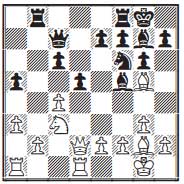
15…d4
It was difficult to resist this move, but 15...dxc4! was better, when Black is a bit better.
16.Qxd4 Ne4
After 16...Nd5 17.Nxd5 cxd5 18.Qxd5 Bxb2 Black is doing well, but 17.Qh4 is ok for White.
Also 16...Rxb2 17.Bf4 with the idea Be5 is level.
17.Bf4
Forced.
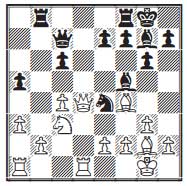
17…e5
I play for maximum tension. Let’s look at the alternatives:
a) 17...Bxd4 18.Bxc7 Bxf2+ 19.Kf1 Nxc3 20.Bxb8 (20.bxc3=) 20...Nxd1 21.Rxd1 (not 21.Bc7 Bc2!–+) 21...Rxb8 22.Kxf2 Rxb2 23.Bxc6 is equal, and Black has no chance to play for a win.
b) 17...Nxc3 was my original intention, but then I saw 18.Qxg7+! Kxg7 19.Bxc7 Nxd1 20.Bxb8 (or 20.Rxd1 Ra8 21.c5 with compensation) 20...Rxb8 21.Rxd1 Rxb2 22.Bxc6 Rxe2 23.Rc1
c) 17...Qxf4!? 18.gxf4 (Black also has compensation after 18.Qxg7+ Kxg7 19.gxf4 Nxc3 20.bxc3 Rfc8) 18...Bxd4 19.Rxd4 Nxc3 20.bxc3 Rfc8 with enough for a pawn.
18.Nxe4 exf4 19.Nf6+ Kh8 20.Qd6 Qxd6 21.Rxd6 Rxb2 22.Bxc6 Rxe2
Black is doing pretty well with the bishop pair. But I was getting very low on time.
23.Rad1 Be6?!
23...Ra2
24.Nd7 Rd8 25.Bf3 Rc2 26.c5 h5 27.c6 Rc3
I was under a minute now and there were still 13 moves to be made to reach time control. White had 4 minutes. I was glad to get rid of the c-pawn.
30...R2xc6! 31.Bxc6 Rxc6 32.Nb8 Rc4 33.Rd8+ Kh7 34.Nd7 Bf5 35.h4 Rc3
It is important not to rush with …fxg3, despite the natural urge to make forcing move to reach the time control.
36.a4 Be4+ 37.Kh2 fxg3+ 38.fxg3 Rc1 39.g4 Rh1+
39...hxg4–+
40.Kg3 Rg1+ 41.Kf2
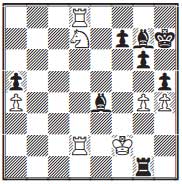
Time control reached, and Black is winning. I thought the win was going to be easy now, but now comes a stupid “finesse”.
41…Rg2+?
It is amazing how common it is to make a mistake on move 41. Usually this happens because one is still moving quickly, but I had settled down and gave this some thought. The simple 41...Rxg4 would win, as the trick White used in the game would not work: 42.Nf8+ Kh6 43.R2d7 Bf6 44.Rxf7 Bxh4+!–+ is check and with the h4-pawn gone, Black can then take the on d8.
42.Ke3 Rxg4 43.Nf8+ Kh6 44.R2d7
White has some counterplay and nothing is easy now.

44…Rxh4
If 44...Bf6 45.Rxf7! Bxh4 (45...Bxd8?? 46.Rh7# is the point!) 46.Rdd7
45.Rxf7 Bc2
I have to avoid more of Nelson’s dirty tricks. If 45...Bf5? 46.Rxf5 gxf5 47.Rd6+ Kg5? 48.Rg6#
46.Rf4 Rh3+
Also 46...Rxf4 47.Kxf4 Bxa4 48.Ne6 did not seem easy.
47.Kd2 Be5
It was probably a better try to play 47...Bf5! with the idea 48.Rxf5 Bc3+
48.Rf7 Bxa4?!
48...Bf5 was still good for Black. Now my opponent plays very accurately.
49.Rh7+ Kg5 50.Rd5 Kf6 51.Ra7 Bc3+ 52.Ke2 Rg3 53.Rc5!

This “nothing move” is very annoying. It was almost midnight and I felt it all slipping away. It dawned on me that I could still lose this game.
53…Bb4
I had trouble finding a move, but this is objectively as good as anything else.
54.Nh7+ Ke6 55.Ng5+ Rxg5
This was more lucky than anything else. I had seen that 55...Kf6 56.Rf7# was not possible, but only now I realized that 55...Kd6 56.Ne4+ Ke6 57.Ra6+ would win for White. Fortunately Black can lose a second exchange and draw easily because White has no pawns.
56.Rxg5 Kf6 57.Rd5 Bb3 58.Ra6+ Kg7 59.Raxa5
½–½
After this game I made the drive home and went to bed around 1am. Before I knew it I was back at the tournament and I had another 6 hour game. I botched it again as some strange double blindness came over my opponent and me in a queen ending, as I missed a chance to simply force the queens off and get an easily won king and pawn ending. So, another half point in yet another 6 hour game. Then I had a yet another 6 hour game. Then I had a quick lunch and found myself facing 8th Grade National Champion, NM Mika Brattain. It took me over 5 hours to overcome my student, which is always an uncomfortable matchup. The next morning, I faced 16 year old M.I.T. student Robert Perez, who had shot up from 2200 to 2500 very quickly.
D.Vigorito (2557)
R.Perez (2519)
MA Open, 2012
[D85] Grünfeld
All that I knew of Perez was that he was young, tactical, and fast. I thought I would try to put him off of his Grünfeld, but he was not to be bothered by my move order.
1.c4 Nf6 2.Nc3 d5 3.d4
I acquiesce. No Anti-Grünfeld today.
3…g6 4.cxd5
And here I thought for a long time. Which line to play today?
4…Nxd5 5.e4 Nxc3 6.bxc3 Bg7 7.Be3 c5 8.Qd2 0–0 9.Rc1
This is a normal position, although it was a line that I had never played before. My opponent came up with a novelty in a position that has been seen hundreds of times. This may not be the best move, but it is not clearly bad. I thought for a long time. I based my play on my assessment of the position after my 14th move.
10.Bc4+ Kh8 11.e5 Nc6 12.Ne2
Instead 12.Nf3 f4! 13.Bxf4 Bg4 would give Black good counterplay.
12…Na5 13.Bd3 Be6 14.h4!
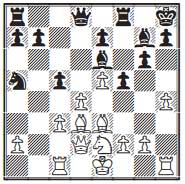
White’s plan is pretty straightforward. My opponent seemed calm enough but after the game he confessed that he was terrified at this point.
14…Nc4
After a long think.
15.Bxc4 Bxc4 16.h5 gxh5
This was the point of Black’s play. There was no real alternative however. White’s attack is not so easy.
17.Nf4 Rf7 18.Rxh5 e6 19.f3 Qa5 20.Kf2 Rd8 21.Rch1
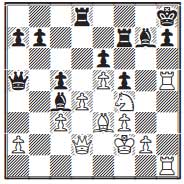
21…Kg8!
This move occurred to me too while my opponent was thinking. I have always liked this kind of move – Black dodges the check before it comes. I had half-expected 21...Bf8 22.Ng6+ Kg8 23.Nxf8 Rdxf8 24.Bh6 with a winning attack, for example 24…Re8 25.Qg5+ Kh8 26.Bg7+ Rxg7 27.Rxh7+ Rxh7 28.Qf6+ Kg8 29.Qg6+ Kf8 30.Rxh7 with a quick mate.
22.Rxh7 cxd4 23.Bxd4 Qxe5?
This too, I had expected, and I replied rather quickly. Objectively better was 23...Qxa2, but White still keeps pressure in the ending.
24.Rxg7+
As planned, but there were two better moves:
a) 24.Nxe6 is the human way to win. If 24...Bxe6? (24...Rxd4 25.Nxd4+– is a normal win)
b) With this theme in mind, there is the engine’s 24.Nd3! when humans would just see 24…Rxd4 and reject it, but the quiet killer 25.Qg5! leads to mate.
24...Qxg7
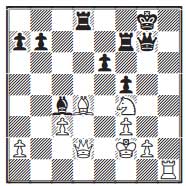
25.Nxe6?
Another mistake, based on a hallucination. The alternatives:
a) 25.Qe3 was what I had planned on playing. After 25…e5(25...Rxd4 26.cxd4 is just good for White) 26.Bxe5 Re7 (26...Re8? 27.Bxg7 Rxe3 28.Bd4 wins) 27.Bxg7 Rxe3 28.Kxe3 Kxg7 29.a3
b) 25.Rh3! was shown to me by Robert after the games. I should have seen this as I saw the idea. 25...e5 (25...Rxd4 26.cxd4+–) 26.Rg3 (26.Nh5! is even better 26...Qg6 27.Rg3 Qxg3+ 28.Nxg3 f4 29.Nh5 exd4 30.cxd4+–) 26...Qxg3+ 27.Kxg3 exd4 28.cxd4± Perez.
If 25...Rxd4 26.Nxd4 f4 27.Rh3 was what I had seen. I thought that Black could not take the knight.
26.Rh8+
Winning, I had thought. Drawing was the truth, but I was lucky it was not losing.
26…Qxh8 27.Qg5+ Rg7
I had overlooked that this shut my bishops attack on h8. I am lucky I have a draw.
28.Qxd8+ Kh7 29.Qh4+ Kg8
½–½
This third near-miss left me in a terrible position. Had I won this game, I would have been tied with GM Alexander Ivanov at 4/5 and we would have played in the last round. In the event that we drew, only Denys Shmelov could catch us if he won his last game with Black. By failing to win this last game, not only had I not knocked out Perez, but now I would still face Ivanov and I would be a half a point back. So now I would have to win, and I would have Black (my third consecutive MA Open facing Alex with Black!). I actually managed to seize the initiative very quickly, but Ivanov defended well, and then with 10 minutes to 3, I managed to think for six minutes to hang a piece outright on move 27... So I managed to hose Perez and Shmelov out of a possible tie for first, and so Alexander Ivanov deservedly won the state championship yet again!
|